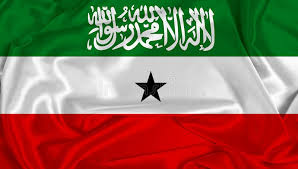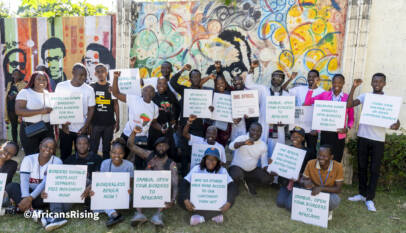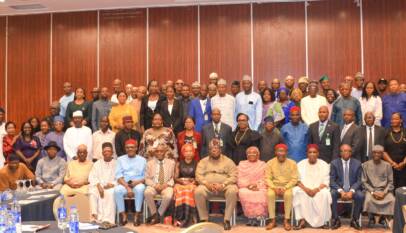OP-ED | The Unrecognized State: Somaliland’s 30-Year Stand Against Africa’s Iron Law of Borders, By Wafula Okumu
Somaliland’s 30-year quest for recognition exposes the limits of Africa’s rigid colonial-border doctrine and challenges the African Union to confront a political and legal reality it can no longer ignore.

For over three decades, a quiet, stable democracy has flourished on the Horn of Africa, a beacon of peace in a region synonymous with chaos. This nation, Somaliland, has its own currency, its own army, its own elected government, and its own passport. Yet, in the eyes of the world, and crucially, in the eyes of the African Union (AU), it does not exist.
Somaliland’s story is not one of a typical secessionist movement. It is a profound legal and political anomaly, a direct challenge to the African continent’s most sacred, yet most problematic, doctrine: the principle of uti possidetis juris—the iron law that perpetuates colonialism on African borders.
The dilemma is stark. On one side stands the AU, fearing that recognizing Somaliland will open a “Pandora’s Box, unleashing a wave of border revisionism and fragmentation across the continent. On the other side is a fully functioning, self-governing state that claims it is not breaking a border but merely restoring one—the distinct boundary of the former British Somaliland Protectorate, which existed before a disastrous, flawed union with the former Italian Trust Territory of Somalia in 1960.
The continued non-recognition of Somaliland is more than a diplomatic slight; it is a policy failure that ignores a stable, democratic reality in favour of a rigid, theoretical principle. The question for the AU is no longer if Somaliland is a state, but whether its unique circumstances justify an exceptional, pragmatic solution that could redefine the future of African sovereignty.
The Flawed Marriage of 1960
Somaliland’s claim to independence is rooted in the argument that its union with Somalia in 1960 was legally flawed from its inception and failed catastrophically in the decades that followed.
On June 26, 1960, British Somaliland gained its independence. Five days later, on July 1, it voluntarily united with the newly independent Italian Trust Territory of Somalia to form the Somali Republic. This “come-we-stay” union, as legal scholars like Judge Eugene Cotran described it, was rushed, romantic, and ultimately, legally unsound.
The legislative instruments intended to formalize the union were never properly enacted. The Provisional President’s decree unifying the two territories was never converted into law as required by the Constitution. As Judge Cotran noted, the key legal documents—the Union of Somaliland and Somalia Law and the Somalia Act of the Union—were never formally signed by representatives of both territories.
A retroactive “Act of Union” was passed in January 1961, but this action arguably breached the very constitution it sought to uphold. The failure to properly formalize the union was a symptom of a deeper incompatibility. The two territories had inherited vastly different legal, judicial, and administrative systems from their respective colonial masters, Britain and Italy. The attempt to merge these disparate systems, along with the imposition of a highly centralized, unitary political system, disregarded the decentralized governance models, such as the traditional xeer system, prevalent in the north.
This political mismatch quickly devolved into marginalization and, eventually, brutal military suppression. The military dictatorship that seized power in 1969 focused its wrath on the northern regions (Somaliland), leading to a devastating civil war in the 1980s. The systematic bombing of cities like Hargeisa by the central government remains a scar on the national memory. Following the collapse of the central government in 1991, Somaliland declared the restoration of its independence on May 18, 1991. Since then, Mogadishu has not exercised any administrative control over the territory.
The Case for Statehood: A De Facto Reality
Somaliland’s argument for recognition rests on two pillars: its compliance with the international legal criteria for statehood and its unique historical claim.
The Montevideo Convention on the Rights and Duties of States (1933), which sets the standard for statehood, requires four qualifications: a permanent population, a defined territory, a government, and the capacity to enter into relations with other states. Somaliland meets these criteria in practice, if not in name.
| Criterion | Somaliland’s Evidence | Status |
| Permanent Population | Estimated population of 5.7 million people. | Meets Criterion |
| Defined Territory | The internationally recognized borders of the former British Somaliland Protectorate. | Meets Criterion |
| Government | A stable, functioning, and democratically elected government with effective administrative control over its territory since 1991. | Meets Criterion |
| Capacity to Enter into Relations | Maintains numerous “government-to-government dealings” with states (e.g., Ethiopia, Taiwan, UK, UAE) and international organizations (e.g., EU), including hosting consulates and liaison offices in Hargeisa. | Meets Criterion (De Facto) |
Under the declaratory theory of statehood, meeting these factual and objective criteria should be sufficient, regardless of formal recognition by other states. The 1991 British commercial court ruling in Republic of Somalia v Woodhouse Drake & Carey (Suisse) SA further supports this pragmatic view, as the court considered the degree, nature, and stability of administrative control as a key factor in determining the existence of a government.
However, Somaliland’s most powerful argument is its historical one. Its independence is not an act of secession that seeks to create a new border, but an act of re-establishing the original colonial boundary that existed prior to the failed 1960 union. This directly invokes the spirit of the AU’s own border principle. The AU’s commitment to uti possidetis (Latin meaning “as you possess”) is to respect the “borders existing on achievement of independence.” Somaliland achieved independence within its colonial borders on June 26, 1960. Its separation from Somalia is therefore a restoration of a recognized colonial boundary, not a revisionist claim. This makes Somaliland a unique case, distinct from irredentist or sub-state secessionist movements that seek to redraw existing lines.
The Cairo Resolution and the precedent problem
The AU’s reluctance to recognize Somaliland is rooted in its interpretation of the 1964 Cairo Resolution, which is the legal foundation for the inviolability of colonial borders. The resolution states that all member states “pledge themselves to respect the borders existing on their achievement of national independence.”
The original intent of the resolution was pragmatic: to prevent interstate conflicts arising from irredentist claims, such as Somalia’s own historical claims on the territories of its neighbours. It was not explicitly designed to preclude internal boundary adjustments or the dissolution of a failed union, especially one where the internal border was itself a former international colonial boundary.
Yet, the AU has adopted a maximalist interpretation, treating the resolution as a blanket prohibition on all border changes—often incorrectly termed the “intangibility principle.” This interpretation is codified in Article 4(b) of the AU Constitutive Act.
Defenders of this rigid stance argue that recognizing Somaliland would set a dangerous precedent, potentially destabilizing countries with their own internal separatist movements. However, Somaliland counters this “Pandora’s Box” argument by pointing to two key precedents already set by the AU: Eritrea and South Sudan.
| Case | Parent State | AU/OAU Stance | Key Distinction |
| Eritrea | Ethiopia | Recognized | Independence was based on the restoration of a distinct Italian colonial boundary and followed a prolonged war and a referendum. |
| South Sudan | Sudan | Recognized | Independence was achieved through a negotiated process and a referendum, following a comprehensive peace agreement. Sudan and South Sudan are separated by the 1 January 1956 British colonial boundary. |
| Somaliland | Somalia | Unrecognized | Independence is based on the restoration of a distinct British colonial boundary and the failure of the parent state. The lack of a negotiated settlement with Somalia is the primary obstacle. |
While both Eritrea and South Sudan were ultimately recognized, the key difference for Somaliland is the lack of a negotiated settlement with Somalia. The international community tends to favour the position of the parent state, making Somalia’s assent—or at least a negotiated agreement—a likely prerequisite for full UN and AU membership. This is the political hurdle that Somaliland must clear, even with its strong legal and historical case.
A path forward: criteria for exceptionalism
The continued denial of recognition is not a defence of the uti possidetis principle, but a perpetuation of instability and an obstacle to regional integration. The AU must develop a policy framework that addresses cases of state failure and the restoration of colonial boundaries without undermining the core principle.
A criteria-based approach for exceptional cases of state dissolution and re-establishment of colonial borders is the most pragmatic path forward. This approach would allow the AU to acknowledge the reality of Somaliland’s de facto statehood while simultaneously safeguarding the continent against widespread fragmentation.
The criteria for such exceptional recognition could include the following. First, an obligation to restore a boundary existing at independence if theclaim is based on the re-establishment of a distinct, internationally recognized colonial boundary that existed before the formation of the failed union. This is the unique legal hook that separates Somaliland from other secessionist movements.
Second, if there is a protracted state failure where the parent state (Somalia) has demonstrated a prolonged and irreversible failure to exercise effective sovereignty and administrative control over the territory for a significant period (e.g., three decades).
Third, if the aspiring state demonstrates a sustained record of peace, stability, democratic governance, and respect for human rights. Somaliland has held multiple successful presidential and parliamentary elections, a stark contrast to the instability in Mogadishu.
Fourth,if the aspiring state formally renounces any irredentist claims on the territory of its neighbours, thereby affirming its commitment to the existing colonial borders it seeks to restore.
The Geopolitical Chessboard
The debate over Somaliland is no longer confined to the halls of the AU. The geopolitical landscape is shifting, and major global powers are increasingly engaging with Hargeisa, driven by strategic interests.
Somaliland’s location on the Gulf of Aden, near the Bab el-Mandeb strait—a critical chokepoint for global shipping—makes it strategically vital. Concerns over counter-terrorism, maritime security, and the competition for influence in the Horn of Africa have led to increased engagement from countries like the United States, the United Kingdom, and the United Arab Emirates.
The US government, for instance, has shown a growing willingness to bypass Mogadishu and engage directly with Hargeisa on security and development matters. Congressional actions and the establishment of a US presence in the capital suggest that external actors are losing patience with the AU’s rigid stance. This external engagement, while beneficial to Somaliland, puts pressure on the AU to either adapt its policy or risk having its norms circumvented by international actors who prioritize stability and strategic access over adherence to a decades-old, arguably flawed, legal doctrine.
A chance to strengthen the AU
The case of Somaliland is a litmus test for the AU’s ability to evolve and adapt its foundational principles to modern realities. It is not a typical secessionist movement; it is the consequence of a failed political union and the restoration of a distinct colonial boundary.
The AU’s rigid adherence to a maximalist interpretation of the Cairo Resolution, while understandable in its goal of preventing fragmentation, ignores the unique legal and historical facts of the Somaliland case. By adopting a nuanced, criteria-based approach, the AU can acknowledge the reality of Somaliland’s de facto statehood without opening the feared “Pandora’s Box.”
Recognizing Somaliland as an exceptional case—one that affirms the original colonial boundaries rather than violates them—would strengthen the AU’s credibility, reward stability and democracy, and provide a constructive solution to a long-standing political and legal anomaly on the continent. The continued denial of recognition is not a defence of the uti possidetis principle, but a perpetuation of instability and an obstacle to regional integration. It is time for the AU to choose pragmatism over dogma and acknowledge the state that has already built itself.
Dr Wafula Okumu is the Executive Director of The Borders Institute (TBI), Nairobi. Kenya. The views expressed in this Op-Ed article are those of the author and do not necessarily represent African Newspage’s editorial policy.














